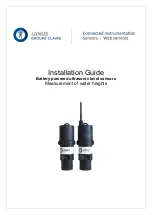
LNU sensor : Installation & programming
Installation Guide
K0J00016-EN-A02
IJINUS – 25 ZA de Kervidanou 3 – 29300 MELLAC – FRANCE
-
www.ijinus.com
-
11
CASE 3:
Complex case
The presence of many echoes makes the simple calibration inappropriate.
The best option is to move the sensor if
possible. Otherwise go to the expert mode.
(Only for experienced users).
Calibration of the sensor Case N°1 (Ideal)
The first case presenting only one echo, you only need to adjust the water height
H
or the maximal distance
between the sensor and the bottom
Z
and relaunch a measure
.
Note that it is possible to define a different zero
point (zero at the level of an overflow threshold for example), very useful for stormwater overflows.
Sensor zero-point (example of ideal case) – On the right a different zero-point
Once done,
the calibration must be confirmed by clicking on “Apply” button
. The configuration is then
automatically saved in a file called “configuration”. This file can be found within the software even when
disconnected from the sensor.
To be noted: the echo figure includes a power indicator, showed as a yellow dot line (oblique from left to right).
This one is very useful to fine tune the sensor. The echo should ideally be above that line. A weak echo means
the measurement is not precise. An echo that is too high provides accurate measures but uses more energy. A
temperature check during the measure also must be done (here 23°C at the bottom of the graph). Although the
measure is temperature compensated, you should not calibrate a sensor when the temperature is too high and
then ask it to measure on a different environment (typical case of 15°C under a sewer manhole).


























